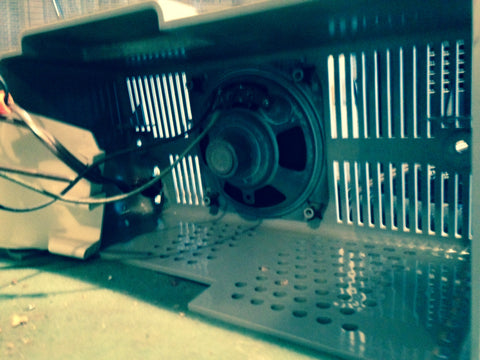Late Fifties General Electric C-405 Looking For a Loving Home
I received an email about a month ago from a nice woman from Long Beach CA. She is the original owner of this old GE C-405 that she used back in the fifties and sixties. She held on to it all these years because she thought it would be worth something some day. She wanted me to find a good home for it.
Here is her statement," I have a General Electric Clock, Model C405 or 406 or 407 (according to instruction paper) which I have owned since sometime in the 50's. It doesn't work, but I have kept it as I realized it might be valuable to someone who would like to repair it.
Just because I want it to continue to have a good home, I would be happy to mail it to you, unless you are out of the USA."
"I am glad to know the radio has such a good home. As for the questions you asked, I seem to remember in the late 50's or 60's, my friends and I were using clock radios for morning alarms. However, I do not recall when or how I acquired the radio. I suspect I put it on a Christmas list. It has never been serviced which explains why it doesn't work!!




Here's all the pieces disassembled:

The original 50C5 tube was no longer working so I replaced it with a good 50C5. I tried to power it up but it didn't work.
(3) Turns out, the power cable interconnect was damaged so the clock radio was not getting any power. The cable base looked fine on the outside, but one of the wires had broken off inside the sheathing. Not an easy fix.

I decided to replace the cord altogether. This would mean rerouting the power cable through a replacement stress bushing.

Not a perfect fit, but functional.
(4) A whole handful of bits and pieces of plastic were flying around inside the cabinet. Plastic mounting posts were cracked off. Clock mount edges were sheared off at the metal clip joints. The back enclosure suffered a crack by the power cord attachment. See the little tray of broken parts:

Fortunately, nothing was missing. So, no filler or patching or repaints would be required to restore this beauty. All in all, this radio was going to be salvageable and restorable.
I wired everything up for a quick bench test and here's what it sounded like.
No filter capacitor hum. Amazing. See the original filter capacitor (Orange thing at the bottom):

I decided to replace the filter capacitor anyway.

(5) ...and the hits keep coming. The radio worked but the clock didn't. I checked and saw the clock was getting power, but the motor wasn't turning. Electronics cleaner didn't free up the movement either. I disassemble the clock movement and found the clock motor was seized internally. Not a simple fix. The clock motor needed to be replaced.

Now that the clock was working, it needed to be securely mounted but the plastic edges on the radio front had broken off where the clock mounted with metal clips. I had to attach the clock using small bolts. The bolts needed to be filed down flush with the clock dial face or else the clear plastic bezel would not clip in.

The plastic posts to mount the circuit board assembly had also broken off. These had to be rebuilt with some melted plastic. Not pretty but it works:

Here's all the sub-assemblies repaired and ready for re-assembly:

Nice and clean!

Spiffy!

(6) Lastly, I polished the clear clock bezel with Novus 3 stage acrylic restoration polish. Good stuff! Expensive but worth it! The hazy clock bezel was now clear and transparent almost like new!
(BEFORE)

(AFTER) Here's what it looks like now.
Here's what it sounds and looks like after all the repairs and restoration. Nice!
All proceeds from the sale of this radio will be donated to a worthy cause - The Doernbecher Children's Hospital:
The Doernbecher Children's Hospital is one of the nation's premier hospitals and research centers for pediatric cancer.


